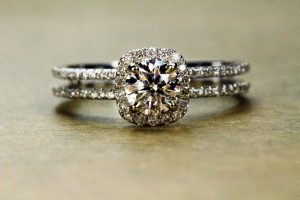This is a new series focused on how any couple headed to the altar can find ways to cut back on spending without sacrificing their vision for the big day. Stay tuned for upcoming posts in this series. The next one will be on wedding venues.
First comes love, then comes marriage, and then comes…paying for the wedding. There’s a reason why none of the fairy tales include the bill. Seeing some of the wedding costs and prices just might shock Snow White right back in her coffin. If you didn’t win our wedding ceremony giveaway, this series will cover some ways you can keep costs down for your wedding.
WeddingWire gathered data from over 18,000 newlywed couples in 2018, and found that the average engagement ring cost $5,000. If that number makes your jaw drop, have no fear, look into these options.

1.Get a used or family ring. If your family has a ring to offer up for your partner that’s great! But if they don’t, looking for used rings can be a good alternative. Some people feel uneasy about getting a used ring for superstitious reasons. A way to ease that fear is to get the used rings blessed by someone in your religious faith to get rid of any bad luck.
2. Buy rings made with lab created diamonds and/or gemstones. Lab created jewels are a much cheaper alternative and they are easier to source than natural diamonds. Moreover, 15-20% of natural diamonds that are labeled conflict-free have been obtained unethically or using unsound environmental practices. Lab created diamonds/gemstones are made by humans, so they're a great option for those trying to be environmentally and ethically conscious.
3. Accept flaws in your stone. Gemstones are rated on their cut, clarity, color, and carats (known as the 4 Cs). Stones that are closer to the intended color (colorless for diamonds), clearer, heavier, and a better cut (reflects more light) are more expensive than those that are not. If you're open to having engagement ring stones that are less than perfect, this is great way to save money. Many jewelers have information on their websites about the 4Cs and include visuals on the differences.
-
- Clarity. A diamond that has a slight cloud or feathering to it is going to be cheaper, because it is not flawless (most diamonds have some flaws). This holds true for lab created diamonds as well. The more noticeable the flaw, the less the gem will cost. However, gemstones are rated on a scale, and if you can find a gem with flaws that you can live with, you'll save some money, while still feeling good about your ring.
- Carat. Carats measure the weight of a gemstone, and the heavier it is, the higher the cost. You may be able to find a stone that looks identical, but weighs less, and therefore, costs less. Avoiding “magic numbers” like 1 or .5, and coming in a little lower could save you money as well. For instance, instead of getting a 1 carat stone, you could get a .92 carat stone, and that could save you as much as 15%, even though the stone might be just as wide as the 1 carat. Experts say that pear shaped gems tend to give you the most sparkle per carat, given their long flat cut.
- Cut. Just like clarity and carats, there's a scale to determine how well a stone is cut. An Ideal cut reflects most of the light that enters the gem, making it appear sparkly and bright. This type of cut is just the top 3-5% of gems. If you downgrade to a Very Good cut, it covers about 15% of gems. It reflects almost as much light as the Ideal cut does, but for a lower price. Keeping these slight differences in mind when shopping for a ring or gem, can help you save plenty of money that you can use on the wedding itself.
- Color. Color, like the other Cs, also has a scale. The most expensive diamonds are colorless, and are the rarest of diamonds. Further down the scale you have near colorless diamonds, which have some color, but they are undetectable to the naked eye. Buying a diamond in this category will again, save you money without sacrificing your vision for the ring. However, this color scale only applies to white diamonds. Colored diamonds have their own scale, depending on the intensity of the color it is intended to be.
4. Opt for a non-traditional gemstone. If you’ve never felt that enthusiastic about diamonds, consider other gemstones as your main stone in the ring. These gems are just as gorgeous, but come with a much lower price tag. Because most rings have a diamond as the focus, a ring with a different gem in the center is also going to stand out in a crowd.
5. Avoid buying a ring during the holidays (Thanksgiving - Valentine's Day). Many jewelers will raise their prices during the holidays, since it’s a popular time to propose.
6. If you’re really into sparkle, consider getting a halo setting. A halo setting has a larger diamond in the center, and lots of smaller diamonds around it. These smaller diamonds catch lots of light and make the center diamond appear larger than it is (see above photo). The smaller stones don't cost that much since they're so small. With the halo setting, you can get a smaller, more affordable, center stone that looks a lot bigger with these reflective stones surrounding it.
7. Learn more. Use these BPL titles to help you some more with inspiration and tips for your engagement rings:


Add a comment to: The Thrifty Wedding: 7 Ways to Save on Your Engagement Ring